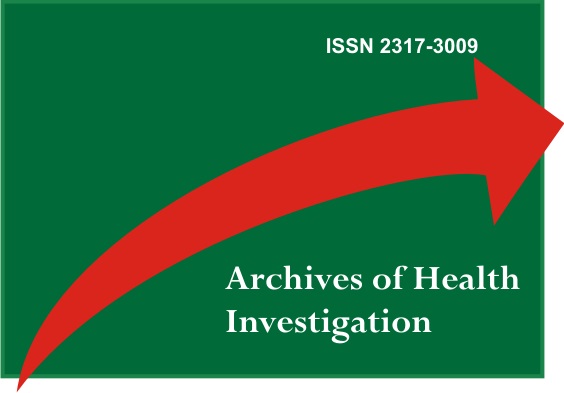Ação da Toxina Botulínica na Disfunção Temporomandibular
DOI:
https://doi.org/10.21270/archi.v11i1.5597Palavras-chave:
Toxinas Botulínicas, Síndrome da Disfunção da Articulação Temporomandibular, Tratamento FarmacológicoResumo
Introdução: A toxina botulínica é utilizada na terapia da disfunção têmporo-mandibular (DTM) por ser uma técnica pouco invasiva, rápida, segura e que demonstra bons resultados. Objetivo: realizar uma revisão de literatura sobre a toxina botulínica na terapia da DTM. Materiais e métodos: Foi realizado um levantamento bibliográfico nas bases de dados: Biblioteca virtual em Saúde, Bireme, LILACS, MEDLINE, PubMed e Scielo. Foram incluídos artigos que continham protocolos terapêuticos sugerindo a indicação da toxina botulínica no controle da dor de origem miogênica na DTM, publicados entre os anos de 2005 e 2019, disponíveis em versão completados na internet. E excluídos testes em animais ou com finalidade estética. Foram usados os descritores: Toxinas Botulínicas Tipo A; Síndrome da Disfunção da Articulação Temporomandibular; Tratamento Farmacológico, combinados pelo operador boleano AND. Resultados: De um universo de 104 artigos, 18 foram selecionados. Foram coletados dados como: mecanismo de ação de 6 marcas comerciais; indicações e contraindicações; tratamento da DTM; e, principais intercorrências no uso da toxina. Conclusão: A toxina botulínica deve ser utilizada de forma adicional ao tratamento multidisciplinar da DTM, pois, apesar de apresentar resultados satisfatórios e eficazes, este não pode ser o único tratamento, visto que a disfunção apresenta etiologia multifatorial.
Downloads
Referências
Gauer RL, Semidey MJ. Diagnosis and Treatment of Temporomandibular Disorders. Am Fam Physician. 2015;91(6):378-86.
Bogucki ZA, Kownacka M. Clinical aspects of the use of botulinum toxin type a in the treatment of dysfunction of the masticatory system. Adv Clin Exp Med. 2016;25(3):569-73.
Awan KH, Patil S, Alamir AWH, Maddur N, Arakeri G, Carrozzo M, et al. Botulinum toxin in the management of myofascial pain associated with temporomandibular dysfunction. J Oral Pathol Med. 2019;48(3):192-200.
Calis AS, Colakoglu Z, Gunbay S. The use of botulinum toxin-a in the treatment of muscular temporomandibular joint disorders. J Stomatol Oral Maxillofac Surg. 2019;120(4):322–5.
Grossmann E, Grosmann TK, Cirurgia da articulação temporomandibular. Rev Dor. São Paulo, 2011.12(2):152-9
Ahmad M, Schiffman EL. Temporomandibular joint disorders and orofacial pain. Dent Clin N Am 2016;60:105-24.
Rossi SS, Greenberg MS, Liu F, Steinkeler A. Temporomandibular Disorders: Evaluation and Management. Med Clin N Am 2014;98(6): 1353-84.
Chisnoiu AM, Picos AM, Popa S, Chisnoiu PD, Lascu L, Picos A et al. Factors involved in the etiology of temporomandibular disorders - a literature review. Clujul Med. 2015;88(4):473-78.
McNeely ML, Armijo OS, Magee DJ. A systematic review of the effectiveness of physical therapy interventions for temporomandibular disorders. Phys Ther. 2006;86(5):710-25.
Feng J, Luo M, Ma J, Tian Y, Han X, Bai D. The treatment modalities of masticatory muscle pain a network meta-analysis. Medicine (Baltimore). 2019;98(46):e17934.
Majid OW. Clinical use of botulinum toxins in oral and maxillofacial surgery. Int. J. Oral Maxillofac. Surg. 2010;39(3):197-207.
Dressler D; Saberi, FA; Barbosa, ER. Botulinum toxin: mechanisms of action. Arq. Neuro Psiquiatr. 2005;63(1):180-85.
Sposito, MMM. Toxina Botulínica do Tipo A: mecanismo de ação. Acta Fisiatr 2009;16(1):25-37.
Dressler, D. Clinical applications of botulinum toxin. Curr Opin Microbiol. 2012;15(3):325-36.
Carruthers J, Carruthers A. Botox: beyond wrinkles. Clin Dermatol. 2004;22(1):89-93.
Botox. 2005. Disponivel em: www.allergan.com.br , acesso em 5 de Agosto, 2018.
Wenzel, RG. Pharmacologyc of Botulinum Neurotoxin Serotype A. AM J Heath Syst Pharm, 2004;61(6)55-60
Colhado, OCG; Boeing, M; Ortega, LB. Toxina Botulínica no Tratamento da Dor: artigo de revisão. Rev Bras Anestesiol. 2009;59(3):366-81.
Marciano A, Aguiar U, Vieira PGM, Magalhães SR. Toxina Botulínica e sua aplicação na odontologia. Rev Inic Cient UninCor. 2014; 4(1):65-75
Hoque A, McAndre M. Use of Botulinum Toxin Indestistry. N Y State Dent J. 2009;75(6):52-5.
Pihut M, Ferendiuk E, Szewczyk M, Kasprzyk K, Wieckiewicz M. The efficiency of botulinum toxin type A for the treatment of masseter muscle pain in patients with temporomandibular joint dysfunction and tension type headache. J Headache Pain. 2016;17:29.
Carrara SV, Conti PCR, Juliana SB. Termo do 1º Consenso em Disfunção Temporomandibular e dor Orofacial. Dental Press J Orthod. 2010; 15(3):114-20
Bueno, GH. Uso da toxina botulínica no tratamento de desordens temporomandibulares. Dísponível em: <https://repositorio.unesp.br/bitstream/handle/11449/149595/000869729.pdf?sequence=1>. Acesso em: 16 Out, 2018.
Rafferty KL, Liu ZJ, Ye W, Navarrete AL, Nguyen TT, Salamati A et al. Botulinum toxin in masticatory muscles: Short- and long-term effects on muscle, bone, and craniofacial function in adult rabbits. Bone.50(3):651-62.
Freund B, Schwartz M, Symington JM.Botulinum toxin: new treatment fortemporomandibular disorders. Br J OralMaxillofac Surg 2000;38(5):466-71
Clarck GT, Stiles A, Lockerman LZ, Gross SG. A Critical Review of the Use of Botulinum Toxin in Orofacial Pain Disorders. Dent Clin North Am. 2007; 51(1):245-61.
Amantéa DV, Novaes AP, Campolongo GD, Pessoa de Barros T. A utilização da toxina botulínica tipo A na dor e disfunção temporomandibular. JBA, Curitiba. 2003;10:170-73.
Kurtoglu C, Gur OH, Kukcu M, Sertdemir Y, Guler-Uysal, Uysal H. Effect of botulinum toxin a in myofascial pain patients with or without functional disc displacement. J Oral Maxillofac Surg. 2008;66(8):1644-51.
Ernberg M, Hedenberg-Magnusson B, List T, Svensson P. Efficacy of botulinum toxintype A for treatment of persistent myofascial TMD pain: a randomized, controlled,double-blind multicenter study. Pain. 2011;152(9):1988-96.
Bartley J. Breathing and temporomandibular joint disease. J Bodyw Mov. 2011;15(3):291-97.


